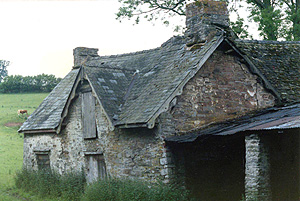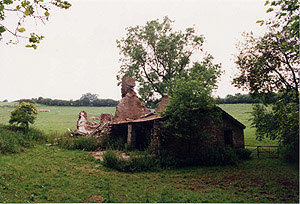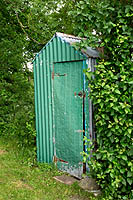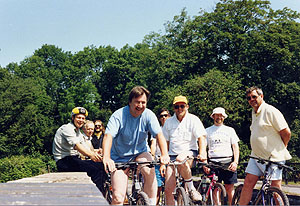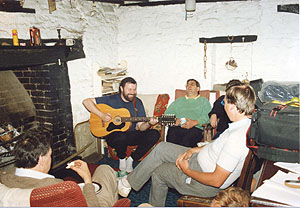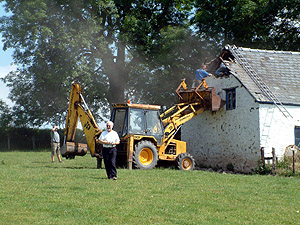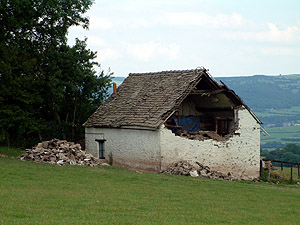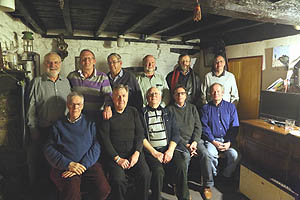Life at the Waun before the 1950’s
Up to the mid 1950’s, the Waun had had a variety of tenants,
including at one time, the Nawed family. Johnny Nawed once recounted
a story, which may be untrue. Looking through a hole in the bedroom
floor, he spied his mother giving birth to a new sibling. Happy
days.
In the cottage there were three downstairs rooms and two bedrooms.
No one knows the age of the place, but it was probably built sometime
between 1750 and 1850. It was roughly built of stone and like
so many workmen’s cottages was erected on the edge of common
land. One meaning of the Welsh word, Waun, is a common. Although
it was subsequently fenced in, the name is still evidenced today.
Both Llwynpenderi and the adjoining farm, the Gaer, refer to their
“common field”.
The roof was originally tiled with local sandstone. These tiles
were very heavy and partly replaced by Welsh slate in the railway
age. The water supply was a well next to the road near the end
of the Waun garden, which was intermittent and would dry up at
the first sign of a drought. There was a pipe running to the house,
but originally the water was carried. One lady was brought up
in the Waun in the 1940’s and she could recall carrying
the water by hand for the 50 yards or so. Hard work.
It was fortunate that the Waun had not been “condemned”
in the early 1950’s. One theory for its survival was the
fact that there were people in residence and condemning it would
have rendered them homeless.
In 1958, the Waun had been unoccupied for a year or so and Maurice
was using the place as a grain store. The mice must have loved
it.
So how did a teacher and his family from Birmingham come to rent
a small cottage above Ffynnon Gynydd, near Glasbury for over 50
years and how did the life of the area change in that time, when
looked at through the eyes of the one of the tenants ?
A Teacher with little money
Born in 1914, Frank Jones became teacher in Birmingham and,
for a while, was a secondary school head. He had a colleague who
rented a cottage somewhere in Wales which Frank thought was a
good idea. There were long holidays, but not too much money to
spend on them. Somehow, he heard of a place near Llanidloes, but
at £22 (in 1957), the annual rent was beyond his reach.
That place is now submerged behind the Clywedog dam.
For part of the Second World War, Frank was stationed in Swansea.
Keeping friends with two ladies who lived there, Frank took his
wife, Margaret Joyce, and his three children for bucket and spade
holidays each year. Before the coming of the motorways, Hay-on-Wye
was approximately half way between Birmingham and Swansea. Now
Frank liked his beer and in 1958, he stopped off at The Three
Tuns in Hay for a pint. The lady behind the bar was Lucy Powell
and she remained the landlady for many years afterwards.
There Frank met a local teacher, Mr Summers, who lived at Glasbury
House and Frank asked him about places to rent in the area There
were several potential cottages and the Waun was top of the list.
Frank found and met the owner, Maurice Price of Llwynpenderi.
Maurice was reluctant at first, but eventually agreed that Frank
could rent the place for 12 months, starting in July 1958. The
rent was set at £7 10 shillings and a similar amount was
payable in council tax, then called rates. An important factor
for Maurice was that Frank was a schoolteacher, which made him
respectable. It has been extraordinary that this informal tenancy
arrangement remained in place, and was later carried on by their
children when Maurice and Frank passed away.
At that time Maurice owned other unoccupied properties nearby.
The cottage at Cwm ddu was empty, but was later sold by Maurice
and modernised. The future of Cilkenny Farmhouse was different.
It remained unoccupied and was used as a barn for hay and was
never developed. This was partly as a result of Cilkenny having
no vehicular access. Eventually the roof collapsed, and today,
only partial walls and the chimney stack are still standing. If
you visit the place, the site feels both lonely and beautiful.
Electricity arrives, but no flush toilet
In 1958, lighting at the Waun was by hurricane lamp or by a
Tilley pressurised paraffin lamp. The Joneses cooked on two primus
stoves. Heating was by the single open fire. Some coal was purchased,
but the Prices were generous in providing wood for them to cut
up and burn.
The area was first electrified around 1960 by Frank who was never
afraid to take on a new project. He asked an electrician working
at his Birmingham school for a wiring plan and with great self-confidence
he set about wiring the Waun for the first time. The result was
good. Nothing blew up and an independent safety inspection was
passed.
Indoor toilet facilities consisted of nothing more than a potty
under the bed. There was no bathroom and the only toilet was basically
a bucket in a small tin shed next to the garden. In 1958, some
other properties in the area had little better, but by the 1980’s
almost everyone had a flush toilet. Despite this, the Waun was
not brought up to date. Neither Maurice, Frank nor their children
were willing to spend the money. There was no point.
The last cider brew
It was 1961 when farmhouse cider was last produced at Llwynpenderi.
A daily allowance of cider used to be part of a farm worker’s
wage. Old maps showed an apple orchard adjoining most farmhouses
in the area and Llwynpenderi was no exception. There were two
orchards, together with a walnut tree and several large pear trees
around the place. However cider making was dying out. Maurice
and his wife drank very little, if at all, but the resident farm
helper, Holder, was partial to a drop.
One evening, in his Land Rover, Maurice visited a man in Painscastle
with several fingers missing. He could provide the cider making
equipment. I joined the team collecting the apples, which were
mostly strewn on the orchard floor.
Come the day, the equipment was set up. One machine was belt driven
by a tractor and it chopped the apples into a mush. The other
piece of kit was a wooden platform with an outlet and sheets of
coconut matting. One sheet was placed on the platform, and the
mush was bucketed on top. The sheet was then folded to form an
envelope. The process was repeated until there was a pile of envelopes,
one on top of the other. A wooden board was then placed on top
of the stack. The contraption had a frame and a screw at the top.
This was turned by two men using a long horizontal pole.
As the screw bore down, out came the juice. Cupping my hand, I
drank more than my fair share. It was delicious and caused my
hand to turn a red colour. I paid for my greed later with a bout
of diarrhoea. There were over a dozen other helpers and onlookers,
who were either curious or looking to take home some of the juice.
The cider was stored in wooden barrels in the cellar of the old
Llwynpenderi house. It had been unoccupied for the last decade.
Sadly the building had to be demolished in the 1980’s because
it was unsafe. I recall an old lintel above a door that had the
date of 1697 carved into it.
A few months after the cider making, I joined Aubrey and Ivor
to draw off some of the liquid. The resultant cider was only just
drinkable, being too acidic. However, it made you drunk soon enough.
Perhaps we were not careful enough about cleanliness. I don’t
remember much attention being given to cleaning the apples or
washing in general. Maybe proper old fashioned cider was always
like that. It needed a strong stomach.
Last Train to Glasbury
I travelled to Glasbury station in the dying days of Steam.
Like my brothers, I loved to spend much of my school holidays
at the rented Waun cottage. Aubrey and Ivor were approximately
the same age as myself and had become life-long friends. Brought
up at Llwynpenderi, they eventually took over their fathers farming
business.
In 1962, I wanted to spend the remaining Christmas holiday at
the Waun, but was too young to live there on my own. However,
it was agreed that I could stay at Llwynpenderi. On 27 December
1962, Frank dropped me off at Snow Hill station in Birmingham.
Buying a ticket to Glasbury, Frank was surprised to learn that
his son was lucky to be travelling at all. The line from Hereford
was to be closed in the next few days.
Everyone remembers that the Beeching Report precluded the closure
of hundreds of railway lines in the 1960’s. He got the blame,
but the truth was that he was just the messenger. Ordinary families
(including Frank’s) could increasingly afford a motor car
for the first time. In any event, the line through Glasbury had
been earmarked for closure before the Beeching recommendations
were published.
During the train journey from Birmingham to Glasbury, the snow
started to fall. This was the start of the winter of 1962/3, and
there has not been a worse one since.
At Whitney on Wye station, everyone had to get off the train and
board a bus to Hay as the metal railway bridge, just upstream
from the toll bridge, was in a state of disrepair. Presumably,
this was a contributing factor to the closure of the line. At
Hay, we all got on the train again and I got off at the next stop
at Glasbury.
Towering snowdrifts
It was a long walk from Glasbury station to Llwynpenderi, especially
if it is snowing and you are carrying a heavy rucksack. Fortunately,
Ivor Price appeared on a tractor as I reached Ffynnon Gynydd and
he gave me a lift to Llwynpenderi. I was of little help around
the farm and the Prices had enough to do coping with the weather.
As the snow fell over the following days, conditions became much
worse and the country lanes became impassable due to the hedge
high snow drifts. One east facing bedroom at Llwynpenderi had
a vent in the wall. I remember that snow blew through the vent
and formed a small pile on the floor. It was so cold that it did
not melt straightaway.
It was my time to leave when the Birmingham schools were about
to start again. Frank was to pick me up by car, but he could only
get his car as far as Llowes. All the minor roads above were still
blocked by snow. Not even the tractors could get through now.
Consequently, the only way out was to walk the two miles or so
down the valley. Some drifts towered above me and most of the
lanes were full of snow up to the top of the hedges. For me it
was an adventure, but they were very different and difficult times
for the farmers.
Walls nearly falling down
Around 1971, the outer skin of the wall above the front door
was bulging badly. Steve, (that’s me and Frank’s youngest
son) helped by Val, his wife to be, and some friends decided to
put it right. The bulge was taken down stone by stone and whilst
working, the mummified remains of several dead mice were found.
They made a strange sight. During rebuilding, a message was put
in a bottle in amongst the replaced stones. It is probably still
there.
The only major structural change during our 56 year occupation
was done in 2006. The west wall was bulging and this was far more
serious proposition than the previous one. The whole wall needed
to be rebuilt. The then owners were Maurice’s two sons,
Aubrey and Ivor Price. They repaired the wall and took the opportunity
to raise the roof by approximately one metre at the same time.
200 feet and still
no water
In 1992, Aubrey and Ivor Price decided to have a bore hole dug
just behind the Waun. As well as giving the Waun reliable water,
it would also supply the animal troughs in their fields.
The Jones family were not present when the drilling started. This
was fortunate as there was probably a lot of dust and noise. The
deal with the contractor was that he would only get paid if water
was found.
The project did not go well for the contractor. Deeper and deeper
went the drilling, but no water was found. The drillers were on
the point of giving up. The depth they had reached was nearly
the same level as Glasbury village. Suddenly, when water was struck,
it rose in a tall column up the hole. The supply has been reliable
ever since and the quality is so good, you could sell the stuff.
Pity the users of the mains water supply in the valley, who have
to put up with treated river water.
56 years of landscape changes
The hill farms around the Waun made (and still make) their main
living from sheep and cattle rearing. The differences between
1958 and 2014 have been the advance in mechanisation and the decline
in subsidiary husbandry. In 1958, pigs, hens, ducks, geese and
horses were all kept at Llwynpenderi. These animals were important,
but did not provide the main source of income. By 2000, they had
gone. However since then, one horse has been kept for recreation
and laying hens have returned.
Working horses began to disappear in the 1940’s as tractors
became affordable. Furthermore, many labour intensive practices
disappeared. These included hedge laying and the moving by hand
of feed and fodder. It is hard to imagine today, carrying a large
sack of grain on your back, up a flight of stairs. However that
was how the stuff was moved in 1958.
Most of the field pattern has not changed. The greatest changes
to the local landscape have been :-
- The growth in the size of farm buildings, which was encouraged
by subsidies. Larger buildings meant greater efficiency as animal
feed and muck could be shifted mechanically, instead of using
a hand fork.
- The lowering of the average hedge height, which in the 1950’s
could be 3 metres or more.
- The grubbing out of cider orchards, as there are fewer labourers.
- The increase in woodland on some common land. For instance,
Bryn Rhydd common is no longer grazed and the tree cover is becoming
more extensive.
- The views of the valley farms in May now contain a spread of
deep yellow patches. These are oil seed rape and were unheard
of as a crop some years ago.
- The death of so many elm trees in the 1970’s, following
disease.
Winter animal feed has changed. Gone are the mangels and turnips
which were harvested by hand and involved much hard work. Grain
for cattle feed is now bought in, rather than grown on the farms
because subsidy payments favour this. The main way of preserving
grass has also changed. Hay is still produced, but most grass
is kept as winter feed in the form of silage.
2014 – Time for change
Maurice Price and Frank Jones died in the 1990’s and after
this the informal Waun tenancy had been continued by Aubrey and
Ivor. By 2014, the Price brothers were nearing a possible retirement
age and the Waun needed to be sold.
It had been a wonderful holiday home for the Jones family and
I shall always be grateful to the Prices for letting us have use
of the place.
For the purposes of the auction held in July 2014, the brothers
increased the foot print of the Waun and its overgrown garden
(my neglect) to 0.4 acres. It was sold for £254,000, which
put it out of reach of many locals who were interested. The new
owner is a vet from Cheltenham who will again use it as a holiday
home. I wish him well.
Steve Jones
October 2014 Birmingham

